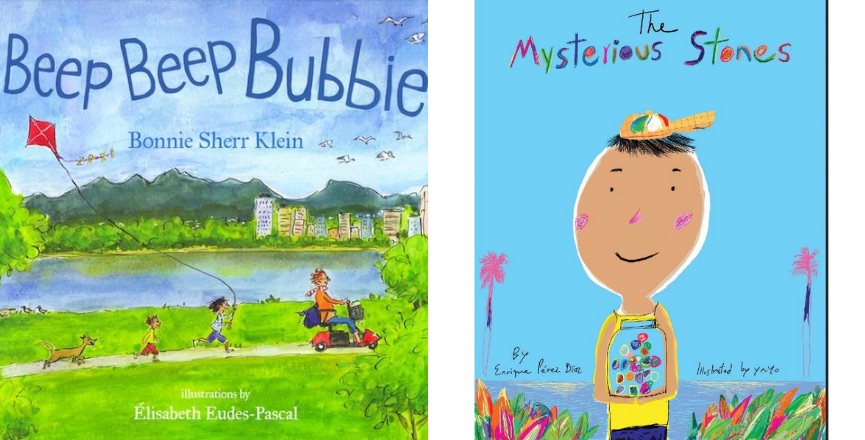Two beautiful new children’s books from Tradewind Books, with stories of loss, adaptation, and resilience, are perfect for these uncertain COVID times.
In Beep Beep Bubbie, by Bonnie Sherr Klein with illustrations by Elizabeth Euder-Pascal, Kate and Nate love spending Saturday with their grandmother, Bubbie. She’s always been the coolest grandmother ever, taking them to dances and climate marches. So they’re dismayed when they arrive at her house and she rides out in a new mobility scooter to greet them.
“What fun can we have on a scooter anyway?” Kate asks. Bubbie sets out to show them, taking them on Vancouver transit to the huge Granville Island farmers’ market near the Pacific Ocean.
Their mission: to find apples for the approaching Rosh Hashanah holiday.
Bubbie’s scooter accommodates the apples, Bubbie’s little dog Luna, Luna’s poop bag, and even a miniature kite to fly at the nearby park, in the ocean breeze. Back at Bubbie’s house, Kate and Nate decide they like her new scooter so much they want to decorate it and give it a name.
Among the lavish, vibrant illustrations, Beep Beep Bubbie deals lightly with disability and multicultural issues. Bubbie shows off her skill in taking the bus with the children, because every Vancouver bus has a ramp and a protocol for wheelchairs and scooters.
“Scooter coming on!” the driver announces. “Everyone move back, please.”
Throughout the book, and especially when the trio visits the park, the people around them reflect Vancouver’s diversity — through plenty of multicultural BIPOC images — with an emphasis on including children living in wheelchairs.
Author and filmmaker Bonnie Sherr Klein is a legendary figure in the documentary world. She and her husband, Dr. Michael Klein, arrived in Canada in 1967 as war resisters. An anti-war activist and writer as well as a filmmaker, she shifted focus to disability issues after suffering two catastrophic strokes. Her awards include two honorary doctorates, a Governor General’s Persons Case Award, and investiture as an Officer of the Order of Canada.
***
The Mysterious Stones by Enrique Pérez Diaz, translated by Alina Ruiz, with illustrations by Yayo, is a story about living with uncertainty, as so many of us do these days. Poignantly, young Kiki lives on a tropical island with his kind aunt (Abuela) and uncle (Tio) because his father sailed away on the open sea. He dreams one night of his papa, and awakens to mysterious music coming through his window.
Following the song down to the ocean, Kiki sees a woman with long white hair on the beach, gathering rocks. She flees when he approaches. Back home, his Abuela says she saw the same lady when she was a child. Because the old woman gave her beautiful stones, Abuela called her the Lady of the Stones. When her mother was sick, Abuela put the stones under her bed, and her mother soon was well again.
Kiki begins to haunt the beach in the mornings, looking for the Lady of the Stones. He helps out at home in the afternoons, going to market with his Abuela, or fishing out on the ocean with his Tio. Abuela reassures him: “Your papa will never forget you. He loves you and one day he’ll return.”
To a young child, of course, a week can be an eternity. Kiki’s beach mornings are rewarded when he encounters the woman with long white hair again. At least, she passes him on the beach — and where she was sitting, he finds beautiful stones, like his Abuela’s.
Kiki barters and bargains with the old woman, seeking some tangible connection to his missing father. He wins reassurance of sorts in his dreams, a voice that says, “Never lose hope. Hope is a flower that blooms even in the deepest ocean.”
Although The Mysterious Stones is set on an unidentified tropical island, millions of children around the world are living out similar stories, staying with extended family (if they’re lucky) while their immediate family members seek work abroad in order to send back remittances. Even with the kindest of adult care, a child couldn’t help being anxious about possibly losing their parent(s).
The vividly coloured illustrations use collage and layering techniques to add depth to the pages. The beach boulders look like cantaloupe skins; the ocean brims with stamped flying fish and cutouts for a porpoise and a pelican. Line drawings of trees, vines, and foliage frame the window where Kiki and his Abuela compare their brightly colored beautiful stones. The end papers feature what could be rocks of all colours and patterns, but actually look like electron-scan images of individual grains of sand.
By seeking the Lady of the Stones, and by trying to up the ante by offering her his collection of assorted sparkling polished glass fragments, Kiki shows his agency. He can’t take control of his own destiny yet. However, as long as he has hope, he can keep negotiating for more tools, and keep seeking new goals — which may be all that any of us can wish for, in uncertain times.
Award-winning author and journalist Penney Kome has published six non-fiction books and hundreds of periodical articles, as well as writing a national column for 12 years and a local column in Calgary for four years. She was editor of Straightgoods.com from 2004-2013.



